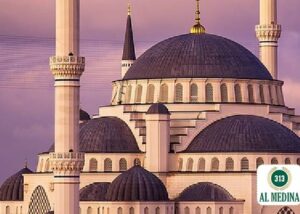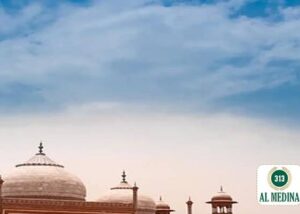If a room is connected to the Masjid prayer area, is it legally part of the Masjid?
Quran
Hadith
Islamic Text
In the Hanafi Madhab, whether a room connected to the prayer area of the Masjid is considered part of the Masjid is based upon the intention of those who established the Masjid. The parts of the building they intended to be Masjid are Masjid, and those they excluded from the ruling of a Masjid are excluded.
وَجُعِلَتْ لِي الأَرْضُ مَسْجِدًا وَطَهُورًا
(Sayidina) Jabir bin ‘Abdullah (May Allah Most High be pleased with him) narrated that, The Messenger of Allah ﷺ said: ‘The (entire) earth has been made for me a place of prostration (Masjid) and a means of purification.’ (Sahih al-Bukhari, 335).
The Hadith above is amongst the evidence used to establish the fact that there is a legal difference between a Musalah (prayer area) and a Masjid. The entire earth is a place of prostration, meaning one can pray anywhere, as long as it is pure. However, the entire earth does not have the legal restrictions of a Masjid. Therefore there is a difference between a place of prayer (Musalah) and a Masjid.
This is an extremely important issue since it impacts many legal rulings. Amongst them, the permissibility of women entering, permission to trade and the validity of I’tikaaf.
Many people are under the misconception that, a place where people congregate to pray is necessarily a Masjid. This is a clear error and contradicts the very concept of a Musalah. Which is a place where people congregate to pray, but it does not have the ruling of a Masjid.
وَالْأَعْيَادِ إِذَا لَمْ يُجْعَلْ مَسْجِدًا لَمْ يَثْبُتْ لَهُ حُكْمُ الْمَسْجِدِ. (مرقاة المفاتيح شرح مشكاة المصابيح)
And if the Eid Masalah (prayer area) was not established as a Masjid then the ruling of the Masjid will not be applicable to it. (Imam Ali al-Qari, Mirqaat).
In the Nass (text) above, Imam Ali al-Qari makes it abundantly clear that there is a difference between a Musalah and a Masjid. And unless a specific intention is established then a Musalah cannot be considered to have the same legal status as a Masjid.
Another common misconception is that a room or building being connected to the Masjid necessitates that it is also part of the Masjid, or if something is part of the Masjid complex then it is necessarily a Masjid. This is a mistake and does not reflect the position of the Hanafi Madhab.
وَفِي التَّتَارْخَانِيَّة: وَإِنْ صَلَّى عَلَى سَطْحِ بَيْتِهِ الْمُتَّصِلِ بِالْمَسْجِدِ، ذَكَرَ شَمْسُ الْأَئِمَّةِ الْحَلْوَانِيُّ أَنَّهُ يَجُوزُ، لِأَنَّهُ إذَا كَانَ مُتَّصِلًا بِالْمَسْجِدِ لَا يَكُونُ أَشَدَّ حَالًا مِنْ مَنْزِلٍ بَيْنَهُ وَبَيْنَ الْمَسْجِدِ حَائِطٌ وَلَوْ صَلَّى رَجُلٌ فِي مِثْلِ هَذَا الْمَنْزِلِ وَهُوَ يَسْمَعُ التَّكْبِيرَ مِنْ الْإِمَامِ أَوْ الْمُكَبِّرِ يَجُوزُ فَكَذَلِكَ الْقِيَامُ عَلَى السَّطْحِ (رد المحتار على الدر المختار)
And in al-Tataarkhaniyah: Shams al-Aimah and al-Halwani mentioned that, if he prayed upon the roof of his house, which is connected to the Masjid, then it is permissible. This is because if it (the roof) is connected to the Masjid then it is not in a worse state than a house, which has a wall between it and the Masjid. And if a man were to pray in something similar to this house, and he hears the takbir from the Imam or the magnifier (Mukabir), then it is permitted. So it should be likewise for the person praying upon the roof. (Imam Ibn Abideen, Radd al-Muhtaar).
وَكَذَلِكَ لَوْ كَانَ عَلَى سَطْحٍ بِجَنْبِ الْمَسْجِدِ، مُتَّصِلٍ بِهِ، لَيْسَ بَيْنَهُمَا طَرِيقٌ، فَاقْتَدَى بِهِ – صَحَّ اقْتِدَاؤُهُ عِنْدَنَا. (بدائع الصنائع في ترتيب الشرائع)
And likewise, if he was upon a roof besides the Masjid, connected to it, (having) no path between them, and he followed it (the Jama’ah in the Masjid), then his following is sound with us. (Imam al-Kaasaani, al-Bada’i al-Sanaa’i).
وَكَذَا إذَا كَانَتْ دَارُهُ بِجَنْبِ الْمَسْجِدِ فَأَخْرَجَ رَأْسَهُ إلَى دَارِهِ لَا يَفْسُدُ اعْتِكَافُهُ. (بدائع الصنائع في ترتيب الشرائع)
Likewise, if his house was beside the masjid, and he put his head into his house then his I’tikaf will not be nullified. (Imam al-Kaasaani, al-Bada’i al-Sanaa’i).
بَيْتٌ فَوْقَهُ بَيْتٌ وَهُوَ مُتَّصِلٌ بِالْمَسْجِدِ يَتَّصِلُ صَفُّ الْمَسْجِدِ بِصَفِّ الْبَيْتِ الْأَسْفَلِ وَيُصَلَّى فِي الْبَيْتِ الْأَسْفَلِ فِي الصَّيْفِ وَالشِّتَاءِ. (الفتاوى الهندية)
There is a room above a room, and it is connected to the Masjid, connecting the rows of the Masjid with the rows of the lower room. (If) he prays in the lower room, in the summer and the winter, (such a room is still considered to be separate to the Masjid). (al-Fataawa al-Hindiyah).
In the above Nusoos (texts) we have numerous examples of rooms or buildings being connected to the Masjid but not being considered as legally part of the Masjid.
A final misconception I want to tackle is that of being under the same roof as the Masjid. Some people say that everything that shares the same roof as the Masjid is necessarily part of it.
In the Nass below we see that a person wants to add a room to the Masjid building without including it within the legal status of the Masjid. He is permitted to do this prior to allowing general access, but not after it. This clearly contradicts the concept of everything under the roof of the Masjid is necessarily Masjid.
فَإِنْ قُلْت: لَوْ جَعَلَ مَسْجِدًا ثُمَّ أَرَادَ أَنْ يَبْنِيَ فَوْقَهُ بَيْتًا لِلْإِمَامِ أَوْ غَيْرِهِ هَلْ لَهُ ذَلِكَ قُلْتُ: قَالَ فِي التَّتَارْخَانِيَّة إذَا بَنَى مَسْجِدًا وَبَنَى غَرْفَةً وَهُوَ فِي يَدِهِ فَلَهُ ذَلِكَ وَإِنْ كَانَ حِينَ بَنَاهُ خَلَّى بَيْنَهُ وَبَيْنَ النَّاسِ ثُمَّ جَاءَ بَعْدَ ذَلِكَ يَبْنِي لَا يَتْرُكُهُ وَفِي جَامِعِ الْفَتْوَى إذَا قَالَ عَنَيْت ذَلِكَ فَإِنَّهُ لَا يُصَدَّقُ. اهـ. (البحر الرائق شرح كنز الدقائق)
If you say: If he made a Masjid and then wanted to build a house for the Imam or someone else over it, can he have that? I would respond: In al-Tataarkhaniyah the author said: If someone builds a Masjid and builds a room whilst it is in his hand, he can do that. However, if when he built it (the Masjid) and handed it over to the people and then he came to build (the room) he is not permitted to do it. In the Jami al-Fatwa (it adds), if he said I intended this (from the beginning), then he is not believed. (Imam Ibn Nujaym, al-Bahr al-Raiq).
This Nass also demonstrates that the ruling of ‘Masjid’ cannot be changed after it has been established. However, prior to establishing it, one has flexibility.
So, the issue of a room or hall being considered to be part of the Masjid, and therefore sharing the same legal status is based upon intention. There is more detail to this and other related Masail (legal rulings). Therefore, people looking to build or establish a Masjid must study such Masail in detail before embarking upon such a project.
Considering the above, it is absolutely possible for a Masjid complex to include rooms or halls that are not legally recognised to be ‘Masjid’ and therefore do not share the same rulings or restrictions. If this were to be the case, then women in a state of menstruation would be permitted to enter such a room or hall. It would also be permitted for a person to buy or sell in such a place. And for the purpose of I’tikaaf people must be informed that this area is out of bounds and may well invalidate the I’tikaaf.
And Allah Most High Knows Best.
-Answered by Shaykh Noorud-deen Rashid (11.02.2022)
-Special thanks to Sidi Yusuf Asghar for assisting with Nusoos translation.
See also:
How strong is the Hadith about a menstruating woman not entering the Masjid?
The verse about not entering the Masjid in a state of impurity.
Women in menses entering a Masjid
See also video:






